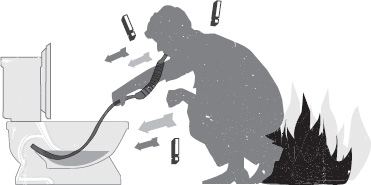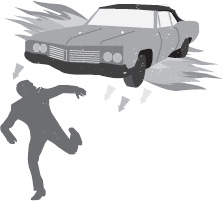Uncle John’s Bathroom Reader Weird Inventions (3 page)
Read Uncle John’s Bathroom Reader Weird Inventions Online
Authors: Bathroom Readers’ Institute

Using the methods employed by those Dutch scientists, creating an entire lab-grown burger patty would set you back an estimated $300,000. Fortunately, a U.S.-based company called Modern Meadow is currently developing a printer capable of cranking out much cheaper artificial meat. The “bio” versions of these machines are still in their infancy. One research group recently built a bio-printer capable of producing chocolate, but more sophisticated material like meat is trickier to pull off. The folks at Modern Meadow hope to create a printer that uses stem cells much in the same way a conventional office printer uses ink. Stem cells can replicate themselves many times over and turn into more sophisticated cells. Hypothetically speaking, a bio-printer could churn out a burger, so long as it has the right material in its “bio-ink cartridge.”
F
un fact: If you’re ever trapped in a burning building, it won’t be the flames or falling debris that will kill you—it will be the smoke. A raging blaze needs oxygen to burn, so it takes that from its immediate surroundings, rudely not considering that you need that oxygen to live. Result: You die.
In 1982 William Holmes patented the Fresh-Air Breathing Device…but we’re going to go ahead and call it the Toilet Snorkel, because that’s what it is. Holmes realized that a good source of fresh air during fires in high-rise office buildings is deep inside the toilet, in the sewer line’s vent pipe. Simply snake Holmes’s slender breathing tube down through any toilet, then into the water trap and beyond, and breathe safely. Why you’re wearing a charcoal-filter fitted mask connected to a tube that’s buried in the toilet will be perfectly explainable to the firemen when they arrive.

D
ealing with
halitosis
, or bad breath, is difficult—obviously, if you knew you had bad breath, you would do something to nip it in the bud, but you can’t, because it’s pretty darn impossible to smell your own breath. That “blowing into your hand and trying to smell it really fast” trick just doesn’t work, so instead you hope you can treat it with prevention, like brushing your teeth eight times a day or eating box after box of breath mints.
In 1925 an inventor named George Starr White was on to something, even if he just mechanized the blowing-into-your-hand trick. His Breath Detector sought to tell a person they had bad breath before someone else could. The gadget was a handheld bellows with a straw-size opening at one end of the barrel and a narrow opening at the other. A person suspecting themselves of having bad breath was to inflate the bellows by blowing into the straw side several times. Then they would deflate the bellows by placing the narrow end in their nose and squeezing. The nose-straw makes sure that you, and only you, smell the questionable breath in question.
T
o watch the video demonstration of the chemical coating called Ultra-Ever Dry on YouTube is to be amazed at the way it repels water, refined oil, wet concrete, and other liquids from seemingly any substance. But to try and explain to Joe Average the phenomenon behind why it works without causing the words “System Overload Imminent” to flash before their eyes…well, that’s a little more difficult.
Basically, it all comes down to proprietary nanotechnology, if that helps. According to its maker and distributor, Ultra Tech International, Ultra-Ever Dry can be successfully used on almost any substance, from metal to plastic to cloth, and once the two-part system—a top coat and a bottom coat—has been applied, it works in temperatures ranging from -30°F to 300°F (-34°C to 149°C). If there’s any limitation to the company’s sales pitch, it’s that the process was designed for work-related functions, which as of this writing has resulted in the company apologetically noting on its website that “we have not had the opportunity to test Ever Dry” for use on the bottom of boats, skis, surfboards, or snowboards. They might not have, but odds are that at least one of the 3.5 million people who’ve watched their video is surfing just above the water at this very moment.
T
oday, we do everything in our cars. Not because we like our cars so much that we never want to leave them, per se, but because the morning and evening commutes take so long that everybody does everything in their cars out of necessity. At least we can make the claustrophobic experience a little better with satellite radio, cupholders, and steering wheel-warmers. (And a little worse with all those empty coffee cups and fast food wrappers on the floor.)

But even in the very early days of the car industry, in the Model T days, there were a number of gadgets available to help a motorist spruce up their bare-bones Ford, including a dashboard flower vase, a detachable roof, even a kitchenette. Since fast food wasn’t yet a thing (it wouldn’t take off until American car culture did, after World War II) in the 1920s, a driver had to buy a Lincoln Kitchenette. You actually had to stop to use it—on roadside picnics and camping trips—but it was a refrigerated metal cabinet that stuck onto one of the car’s running boards and folded out when needed to create a table. Inside, it held 25 pounds of ice, which kept food cold for up to 24 hours. There were also little compartments marked to hold “flour meal,” “ice water,” and “eggs,” which probably didn’t survive the trip.
W
hat ho, and good day, fellow gentleman. I see that your arms are quite laden with packages, overwhelming your spirited walk with various and sundry dry goods and whatnot. How then, I pray ask, are you to tip your hat to a passing lady, as custom requires?
Fortunately, our fellow goodfellow James C. Boyle has, in this very year, the olde-timey annus of 1896, registered with the United States Patent Office his “Saluting Device”! Bully! This most curious, although certainly useful, contraption attaches to the bottom of a hat (which you yourself must provide of your own volition via your finest haberdasher) and affixes to the top of the head. It is wound like a child’s plaything, and all you need do is bow your head slightly. A pendulum sets forth machinery, of which this country is known to be the finest manufacturer, whereupon the hat spins, ever so slowly. But it does a full 360-degree turn and settles back in place. Oh, but what a sight it shall be as it spins about entirely upside down and back. The entertainment of the season! How we shall chuckle and guffaw and yet also be mannerly to the fairer sex!

H
ey, ladies.
Aren’t human guys
sooooo
last century?
They’re always watching sports, they rarely pick up after themselves, and they fart so darn much. Isn’t it time you ditched the irritating and disgusting male in your life? Now you can. Deluxe Comfort, a Detroit-based home product company, has released the Boyfriend Body Pillow.
The pillow, which is shaped like a man’s chest and comes with a plush arm that you can wrap around your shoulders, will happily snuggle with you anytime you feel like it. Plus, the Boyfriend Body Pillow will never leave his tighty-whities on the bathroom floor, and it won’t insist on watching a Golden State Warriors game rather than
Eat Pray Love
. Each Boyfriend Body Pillow comes with a removable microfiber shirt. The pillow is also machine-washable in case you accidentally spill some wine on it during a
Cougar Town
marathon.
Oh, and guys: You may now need to buy one of Deluxe Comfort’s Girlfriend Body Pillows. It’s basically the exact same thing as the Boyfriend Body Pillow, only it comes with a bosom made of memory foam.
A
n
automaton
(plural,
automatons
) is an automatic machine, often mimicking some human or animal action. There are many examples of such devices going back to ancient times, but the most impressive may be the inventions of the Arab engineer Al-Jazari, who lived from 1136 to 1206. Al-Jazari created about 100 automatons, including a 23-foot-tall water-powered clock that included the figures of a driver, a phoenix, and a serpent on the back of a life-size elephant. A series of contrivances sank a bowl into a bucket of water, which raised a seesaw, dropping a ball into the serpent’s mouth, causing the serpent to tip forward and pull the bowl back up with a string. The same water-driven mechanisms triggered the arm of the elephant’s driver to strike a cymbal every half hour, signaling the phoenix to chirp.
Al-Jazari also devised robot waitresses to serve drinks and hand-washing basins that were refilled by mechanical serving girls. But his greatest invention sounds like a tale out of
The Arabian Nights
: a proto-robotic band used to entertain guests at royal drinking parties. Four lifelike robot musicians were mounted in a boat and could be programmed to play different songs by changing the arrangement of tiny pegs in their inner workings. The musicians had over 50 facial expressions and bodily movements, which differed depending on which song they were playing. Not bad for a machine built more than 800 years ago.
I
n 2012 the world came one step closer to science-fiction technology (or “Treknology,” if you will) when Microsoft patented a virtual-reality installation reminiscent of
Star Trek
’s Holodeck—the magical rec room where Starfleet crew members interact with simulated people and objects in a perfectly realistic artificial environment, via sophisticated holograms.
Microsoft’s version builds off of existing virtual-reality technology. Current VR systems require users to wear a special helmet or goggles to simulate a different visual environment. Microsoft’s innovation will use multiple video projectors to shine images on all surfaces of a room, creating a 3-D illusion around the viewer in all directions. The space will appear to be completely transformed.
Even the furniture will seem to vanish; sensors will detect and compensate for any objects in the space, smoothing out visual distortions that would ruin the illusion. Motion detectors will track the viewer’s movement around the room and adjust the projected images accordingly, maintaining a seamless, immersive visual experience. No word yet as to when Microsoft might bring this technology to market, but it’s already gearing up for potential applications for video gaming.
Green alien go-go dancers not included.

